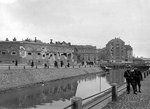parsifal
Colonel
Hello parsifal,
Gentlemen, let's take it easy okay, please
Sometimes one has to see things in order to get a better picture. Right now I can't, but I will scan in a picture tomorrow of my friends AFV Marder 20mm cannon firing a incendiary high explosion shell at a target in a distance of 600m, and you will see what I mean. (Just try to remember it is a single shot at a 2 storey building.
Regards
Kruska
Hi Kruska
I have never discouraged reasoned and respectful discourse about any subject, but I will not tolerate disrespect and straight up lies from anyone. soren has been caught repeatedly doing this, not just to me, but to a lot of people. And he gets away with it a lot.
Anyway, to clarify my position. I never said that buildings offer complete cover, I never even said that artillery could not bring buildings down in a single hit. But the evidence that buildings were used for cover in WWII is just there. it cant be denied, because it happened, used by both sides actually. So why would they do that....
The evidence that I have presented shows that buildings can withstand a fair amount of punishment, and that guns of tank calibre (WWII) were not automatically endowed with the ability to demolish buildings in the manner described. If possible, no doubt the Infantry would stay out of a building until it was reduced to rubble, but this luxury was not always available. In a close combat situation, whre Spoviet artillery concentrations could be as high as an artillery piece every 10 yards, being inside a building might be prefereble to moving outsaide of it, particuarly if you are not allowed to retreat.
How many rounds of your 20 mm canaon were needed to bring this building of yours down. What was the nature of its construction? Was it sandbagged? There are a lot of questions to consider, before writing off a building as not being suitable for defence. The evidence of this can be found in the urban fighting that the US Army is embroiled in in Iraq at the moment (eg Fallujah). Whilst their artillery can destroy buildings, the eenmy still chooses to fight from those buildings, and does it very effectively. always the force that is forced to move into the street is going to take heavier casualties than that which remains hidden and at least somewhat protected by the buildings, particaulalry if the defenders can get into the sewers and the like
Gentlemen, let's take it easy okay, please
Sometimes one has to see things in order to get a better picture. Right now I can't, but I will scan in a picture tomorrow of my friends AFV Marder 20mm cannon firing a incendiary high explosion shell at a target in a distance of 600m, and you will see what I mean. (Just try to remember it is a single shot at a 2 storey building.
Regards
Kruska
Hi Kruska
I have never discouraged reasoned and respectful discourse about any subject, but I will not tolerate disrespect and straight up lies from anyone. soren has been caught repeatedly doing this, not just to me, but to a lot of people. And he gets away with it a lot.
Anyway, to clarify my position. I never said that buildings offer complete cover, I never even said that artillery could not bring buildings down in a single hit. But the evidence that buildings were used for cover in WWII is just there. it cant be denied, because it happened, used by both sides actually. So why would they do that....
The evidence that I have presented shows that buildings can withstand a fair amount of punishment, and that guns of tank calibre (WWII) were not automatically endowed with the ability to demolish buildings in the manner described. If possible, no doubt the Infantry would stay out of a building until it was reduced to rubble, but this luxury was not always available. In a close combat situation, whre Spoviet artillery concentrations could be as high as an artillery piece every 10 yards, being inside a building might be prefereble to moving outsaide of it, particuarly if you are not allowed to retreat.
How many rounds of your 20 mm canaon were needed to bring this building of yours down. What was the nature of its construction? Was it sandbagged? There are a lot of questions to consider, before writing off a building as not being suitable for defence. The evidence of this can be found in the urban fighting that the US Army is embroiled in in Iraq at the moment (eg Fallujah). Whilst their artillery can destroy buildings, the eenmy still chooses to fight from those buildings, and does it very effectively. always the force that is forced to move into the street is going to take heavier casualties than that which remains hidden and at least somewhat protected by the buildings, particaulalry if the defenders can get into the sewers and the like

